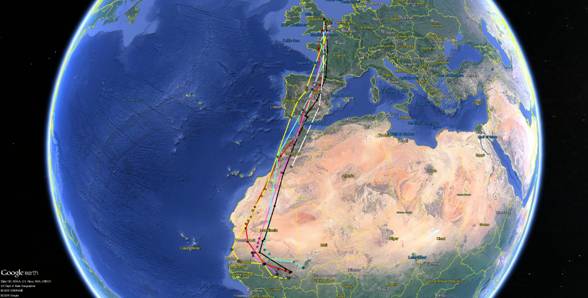Guest blog by Dr John Mallord, Senior Conservation Scientist, RSPB Centre for Conservation Science
Titan our 2014-16 satellite tagged Turtle dove was a superstar; the first UK-breeding turtle dove that was followed on its entire migratory journey from his breeding grounds in Suffolk to Mali and back again – and back to Mali a second time. Nevertheless, he was just one bird, and to get a broader picture of turtle dove migration, we needed to track more birds.
Tagging Turtle doves in the UK earlier this year
Fortunately, the success of Titan helped us get permission to tag more birds in East Anglia in the summer of 2016, and we caught birds at four sites, including our reserve at RSPB Frampton, and three farms in Norfolk, Suffolk and Essex. Sadly, the season didn’t get off to the most promising of starts, as we lost some birds before they had even set off from the UK. You can find out more about what happened to each bird that we tagged on our website.
Challenges on migration from UK to Africa
Of course, once the birds leave the UK on their epic 5000 km southward journey, they are then faced with a whole host of other challenges. This includes the largest natural barrier, the Sahara. Yet, it’s amazing how many birds don’t even make it this far. This year, we lost two birds during this phase of autumn migration, including one on the edge of the desert in Morocco.
Usually when we stop receiving satellite transmissions from birds, we conclude that the birds have died, but we have no way of knowing what the cause of death was. However, one of our satellite tagged Turtle doves was legally shot in Spain and was handed in to the authorities in mid-September near Córdoba in the region of Andalusia in southern Spain. Although a sad end for this particular individual, at least we were able to determine the cause of death.
3 x satellite tagged birds in their African wintering grounds
The three remaining satellite tagged Turtle doves are still going strong, and we continue to pick up daily transmissions from them as they spend the winter in Mali.

Interestingly, all three birds are within 250km of each other along the Niger River and its tributaries, and only 70km from where Titan spent winter 2014/15.
In fact, the whole of their southward journeys show great similarities, and highlight important places along the route, such as the tributaries and floodplain of the Senegal River in southern Mauretania, where all tracked birds, from the UK and France, have lingered after crossing the Sahara in autumn.
In a previous blog I spoke of an area in Mali, near the town of Kayes, that Titan returned to in two successive winters; well, this area has proved popular with quite a few birds, including one of this year’s birds and a number of birds tagged in France. This is important information; although the political situation in Mali may prevent us from travelling to these areas, knowing the location of key places can help us understand the particular threats facing turtle doves while they are on the wintering grounds.

Understanding the requirements of Turtle doves in Africa
As mentioned in previous blogs, we have a team of researchers out in the field in Senegal, learning first-hand what is important to turtle doves in Africa.
They are based at a roost site that holds tens of thousands of turtle doves and other species. However, one piece of information we do not know is where these birds originate from, which breeding populations they are from.
We know that many will be from the North African race; in fact, we had a report of a bird ringed by the team in February 2016 being shot by a hunter in Morocco the following July. However, there are likely to be thousands of birds from Europe.
Satellite tagging Turtle doves in Senegal this winter
We have retrieved three of the satellite tags from birds that died this year, and now we have been given permission to fit these satellite tags to 3 x birds in Senegal, so soon we will get a better idea of where these birds come from.
Find out more
To follow our satellite tagged Turtle doves visit www.rspb.org.uk/turtledovetracking or follow @RSPBScience on twitter








